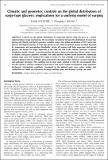Climatic and geometric controls on the global distribution of surge-type glaciers : implications for a unifying model of surging
Abstract
Controls on the global distribution of surge-type glaciers hold the keys to a better understanding of surge mechanisms. We investigate correlations between the distribution of surge-type glaciers and climatic and glacier geometry variables, using a new global geodatabase of 2317 surge-type glaciers. The highest densities of surge-type glaciers occur within an optimal climatic envelope bounded by temperature and precipitation thresholds. Across all regions with both surge-type and normal glaciers, the former are larger, especially at the cold, dry end of the climatic spectrum. A species distribution model, Maxent, accurately predicts the major clusters of surge-type glaciers using a series of climatic and glacier geometry variables, but under-predicts clusters found outside the climatically optimal surge zone. We interpret the results in terms of a new enthalpy cycle model. Steady states require a balance between enthalpy gains generated by the balance flux and losses via heat conduction and meltwater discharge. This condition can be most easily satisfied in cold, dry environments (thin, low-flux glaciers, efficient conductive heat losses) and warm, humid environments (high meltwater discharges). Intermediate conditions correspond to the optimal surge zone, where neither heat conduction nor runoff can effectively discharge enthalpy gains, and dynamic cycling can result.
Citation
Sevestre , H & Benn , D I 2015 , ' Climatic and geometric controls on the global distribution of surge-type glaciers : implications for a unifying model of surging ' , Journal of Glaciology , vol. 61 , no. 228 , pp. 646-662 . https://doi.org/10.3189/2015JoG14J136
Publication
Journal of Glaciology
Status
Peer reviewed
ISSN
0022-1430Type
Journal article
Description
Financial support was provided by the ConocoPhillips Lundin Northern Area Program project CRIOS.Collections
Items in the St Andrews Research Repository are protected by copyright, with all rights reserved, unless otherwise indicated.

